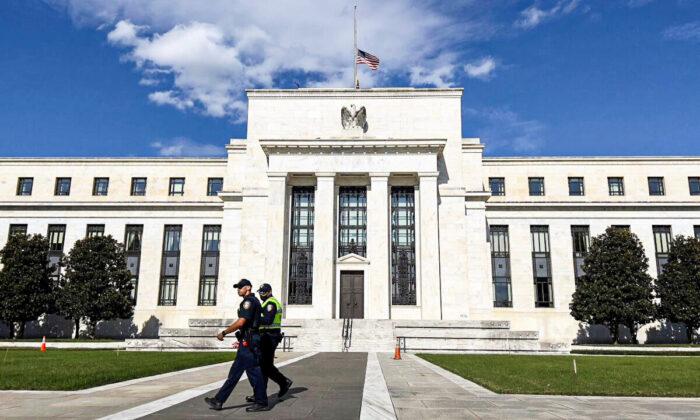LONDON—Stock markets and the dollar moved cautiously higher on Wednesday before the latest Federal Reserve meeting minutes, while New Zealand’s dollar soared as its central bank joined those now aggressively jacking up interest rates.
Nerves about a global recession were jangled on Tuesday by weak U.S. housing market data, but European and Asian trading saw the mood gradually strengthen.
Hints of more stimulus from China and a tick up in German consumer morale lifted Europe’s STOXX 600 0.6 percent early on after MSCI’s main Asian indexes rose around 0.5 percent overnight.
Oil was creeping up again, which along with higher food prices meant more fuel for rising inflation that central banks globally are now struggling to contain.
The U.S. Federal Reserve has vowed to act aggressively by hiking the cost of borrowing and minutes from its most recent meeting, due later, will be parsed for clues regarding the speed and extent of those actions.
Investors currently expect a series of 50-basis-point rate hikes over the next several months, stoking fears that it could easily bring the world’s largest economy to a standstill.
“From our perspective the fears of recession are real,” said Salman Baig, a portfolio manager on Unigestion’s cross-asset solutions team, adding “the Fed has a very difficult job on its hands” to engineer a “soft landing.”
The U.S. dollar index—which measures the currency against six major rivals—rebounded 0.16 percent to 101.92, a level not seen since April 26.
Meanwhile the kiwi dollar hit a three-week high of $0.65 after its central bank raised rates by an aggressive 50 basis points and signaled plenty more to come.
Dislocation
Overnight, Wall Street reeled from weak housing and manufacturing data, and as some top Fed policymakers backed two more big interest rate hikes as early as June and July to fight the U.S.’s 40-year-high inflation.New home sales in the U.S. fell 16.6 percent month-on-month in April, the largest decline in nine years, sending U.S. Treasury yields to one-month lows as investors turned once again to safety. The benchmark 10-year note was at 2.766 percent in Europe, the 2-year yield was at 2.522 percent and 10-year German Bund yields were 0.946 percent.
Wall Street futures were slightly higher after the Nasdaq Composite had dropped 2.35 percent and the S&P 500 lost 0.8 percent on Tuesday.
Atlanta Fed President Raphael Bostic warned headlong rate hikes could create “significant economic dislocation” and was among a handful of Fed policymakers who favor reducing the pace of rate hikes later in the year if inflation cools.
Investors in Asia remain similarly nervous about growth being impacted by the effects of persistent Chinese COVID-19 lockdowns, which threaten to undermine recent stimulus measures in the world’s second-largest economy.
MSCI’s broadest index of Asia-Pacific shares outside Japan rose 0.7 percent, with Australian shares up 0.72 percent, Seoul adding 0.84 percent and Taiwan advancing 1.07 percent. Hong Kong’s Hang Seng and China’s main indexes also traded higher, while Japan’s Nikkei share average slipped 0.2 percent.
“In Asia, investor debate centers on whether or not China’s easing policies are sufficient to offset downward pressures,” Stephen Innes of SPI Asset Management said in a note.
“Fiscal multipliers will be minimal in an economy where economic activity has slowed sharply. Moving beyond mobility restrictions in short order is a pre-condition, but not a guarantee, for an Asia-led economic recovery.” Among the main commodities, gold prices dipped 0.2 percent to $1,862.27 per ounce, having risen to their highest in two weeks on Tuesday, as the greenback gained. Oil prices climbed more than 1 percent on the prospect of tight supplies. U.S. crude futures rose to $111.05 a barrel, and Brent rose to $114.86.





